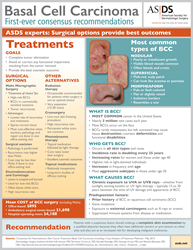ASDS Releases Consensus Recommendations on Basal Cell Carcinoma
Sunday, June 28th, 2015
Rolling Meadows, Ill. (PRWEB) May 11, 2015
An expert group of dermatologic surgeons appointed by the American Society for Dermatologic Surgery (ASDS) Board of Directors has developed the first-ever consensus recommendations on the treatment and management of basal cell carcinoma (BCC), the most frequently occurring form of skin cancer.
The procedural analysis, which also compares the effectiveness and costs of various treatment methods, is featured in the May 2015 issue of the Dermatology Surgery journal.
The document is intended to provide physicians with a set of clinical principles and courses of action for BCC management based on evidence from a comprehensive literature review and the evaluation of treatment methods – taking into consideration cure rates, recurrence rates, aesthetic and functional outcomes, and cost effectiveness.
BCC is the most common cancer in the U.S., with nearly 3 million new cases each year. The top risk factor is exposure to UVA or UVB rays – whether from sunlight, tanning booths or UV light therapy. While BCCs rarely metastasize, left untreated they can cause localized tissue destruction, cosmetic deformities and functional disabilities.
According to the ASDS authors, the ultimate treatment goal for BCCs is complete tumor eradication. As such, they agree surgical approaches provide the best outcomes. Individual treatments vary according to the cancer size, depth, location and other relevant medical history.
Of significance, the authors regard Mohs Micrographic Surgery as an efficient and cost-effective procedure that remains the treatment of choice for high-risk BCCs and for those in cosmetically sensitive locations. They note that non-surgical modalities may be used for low-risk BCCs when surgery is contraindicated or impractical, but the cure rates are lower.
“For a given BCC, the cure rate associated with a treatment modality is the key consideration in choosing the most appropriate therapy,” say the authors, citing that Mohs Micrographic Surgery “provides the highest cure rates while maximizing tissue preservation, maintenance of function and cosmesis. … And because it is performed in the office setting, oftentimes with immediate repair, it is highly efficient and cost-effective.”
In addition to Mohs surgery – which offers complete tumor margin analysis – the authors describe other well-established surgical methods. Caveats are added that standard surgical excision with post-operative pathological examination is usually done with incomplete margin assessment, and intra-operative frozen section margin sampling is frequently incomplete.
According to the data presented, Mohs surgery and surgical excision remain the most effective modalities to treat BCCs.
Alternative BCC treatment approaches also are discussed, including curettage alone or followed by electrodesiccation, radiation therapy, cryosurgery, photodynamic therapy and topical medications. For each modality, the authors systematically review the advantages, disadvantages and associated adverse events.
A cost analysis of the treatment methods shows the outlays for Mohs and surgical excision as well as some non-surgical treatments are comparable, and that radiation therapy, which is less effective, is more expensive. Mohs remains the “most cost-effective method” when other factors are taken into account, including recurrence rates, destructive modalities and the fees associated with the office-based procedure versus ambulatory surgical centers or hospitals.
The authors also recommend that patients with a single suspicious lesion undergo a complete skin examination by a qualified physician because they often have additional cancers or pre-cancers at other sites and also are at an increased risk for developing malignant melanoma.
Within the comprehensive analysis, the experts address other key BCC factors:
Incidence and patterns – Although BCC occurs in all skin types and races, it is most likely to develop in light-skinned individuals. Most BCCs occur on the face. The BCC incidence rate continues to rise, doubling every 25 years. Increasing incidence rates also are occurring in those under 40 and in women. While only 15 percent of BCCs occur in patients under 35, aggressive subtypes occur more often in this age group.
Causes – Chronic sun exposure is the most common risk factor for the development of BCC, with a typical latency period of 15 to 20 years between the time of UV damage and clinical onset.
Clinical features – Although there are many clinical variants, the most commonly recognized types are nodular, superficial and morpheaform BCC. The authors agree that identifying the histopathologic subtype is important because some subtypes behave more aggressively and are likely to recur if not completely eradicated.
Authors of “Consensus for Nonmelanoma Skin Cancer Treatment: Basal Cell Carcinoma, Including a Cost Analysis of Treatment Methods” include: Arielle N.B. Kauvar, MD; Terrence A. Cronin Jr., MD; Randall K. Roenigk, MD; George J. Hruza, MD; and Richard G. Bennett, MD. The BCC analysis will be followed in 2015 with similar recommendations for squamous cell carcinoma (SCC).
About ASDS
The American Society for Dermatologic Surgery is the largest specialty organization exclusively representing dermatologic surgeons who have unique training and experience to treat the health, function and beauty of your skin. ASDS members are pioneers in the field. Many are involved in the clinical studies that bring popular treatments to revitalize skin and fill and diminish wrinkles to the forefront. Their work has helped create and enhance many of the devices that remove blemishes, hair and fat, and tighten skin. Dermatologic surgeons also are experts in skin cancer prevention, detection and treatment. As the incidence of skin cancer rises, dermatologic surgeons are committed to taking steps to minimize the life-threatening effects of this disease. For more information, visit asds.net.
Contact:
Jay Schwab
Communications Manager
American Society for Dermatologic Surgery
jschwab(at)asds(dot)net
847-956-9143
Follow us:
Website: asds.net
Follow ASDS on Twitter: twitter.com/ASDSSkinExperts
Become a fan of ASDS on Facebook: facebook.com/ASDSSkinExperts
Locate a dermatologic surgeon in your area: asds.net/findadermatologist.aspx
